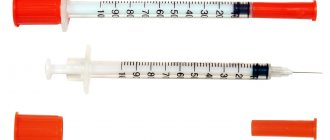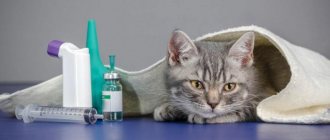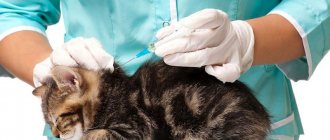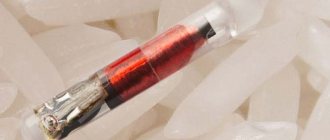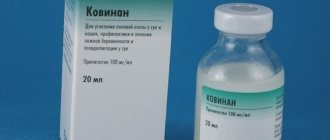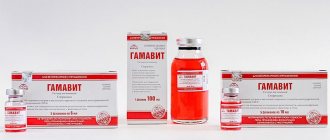General Tips
I suggest considering general tips that will help you carry out manipulations carefully and safely for your pet.
Choosing a syringe
Follow your veterinarian's recommendations regarding syringe volume and needle thickness. Insulin syringes are used for cats because their needles are thinner.
An insulin syringe will not work if:
- you need to administer a dose of more than 1 ml.
- if the substance is viscous and dense, as well as oil-based.
- if the subcutaneous fatty tissue has a high density, since a thin needle may break during insertion.
If a 2 or 3 ml syringe was selected, try not to insert the needle too deeply.
Medicine dosage
Please note that doctors sometimes prescribe one "cube" of medicine, and syringes are intended primarily for people. A syringe cube is 1 ml. For pets, one and a half doses are often prescribed, and syringes are not always marked with 0.5-2.5 ml.
I will explain using the example of a 2 ml syringe. If you need to inject 0.4 ml of medicine, this means that you should not draw 4 ml, but only fill the first four divisions of the syringe! A large dose can cause irreparable harm to the animal!
If medications are prescribed in grams, check the dosage in milliliters. If you have been prescribed NaCl 0.9% (saline), the formula for it is simple: 1 ml = 1 cube = 1 g.
How to draw up medicine correctly
Before handling, wash your hands thoroughly with soap.
First you need to open the ampoule and only after that the syringe. Point the needle into the ampoule and try not to let it touch the walls of the vessel.
Draw up the required amount of medicine.
Lift the syringe with the needle up and tap it with your fingers. Air bubbles will rise and will need to be released by pressing the plunger.
Always take a little more medicine than directed. When you release the air, some of the medicine will come out and you will get the right amount of medicine.
Sterility and safety
It is possible to treat your pet at home, but only if sterility is maintained.
- Never touch the needle with your hands, even with gloves!
- Do not reuse the syringe, even for a new dose of the next medicine.
- Do not use the same syringe for different medications, as a chemical reaction may occur.
- Up to 60 ml of the drug is injected into one point subcutaneously and up to 1 ml intramuscularly. Change injection sites if you need to inject the medicine several times a day.
- The issue of disinfecting the injection site is controversial, since the skin of cats is covered with a natural antiseptic. Check with your doctor about this detail.
- Disinfection is applicable for hairless cats.
- The injection is given only in an intact area of the body that is free of eczema, lichen, wounds and pus. Read about how to treat lichen in a cat in my other article.
Fixing the pet
It is best to carry out the procedure together, so that one can hold the cat and the other can carry out the manipulations. There are several ways to restrain cats.
Method number 1. Lying down
Grab your pet by the withers in a standing position and gently press it against a flat surface until it is in a lying position. If you are giving the injection alone, squat down and hold your pet between your thighs so that the back legs are between your legs. In this position it is easy to give a subcutaneous injection.
Method number 2. On the side
Take the pet by the withers in a standing position, with the other hand by the paws and lay it on its side. If the cat is aggressive, the second person should stand behind the pet and hold it by the limbs, pressing the body to a flat surface with the forearm.
Method number 3. In a bag or towel
A good way is to use a fixing bag, the equivalent of which can be a thick towel. You need to wrap it tightly around your pet, leaving the injection site open.
To prevent the cat from biting, a special bridle is used.
- Take a string or thick tape and thread it through a rubber tube about 10 cm long.
- Open your pet's mouth and place the bandage so that the rubber tube is in the mouth.
- Tie the lace at the back of your head.
If you carry out manipulations alone, pinch the cat's withers with a clothespin to create a feeling of false fixation.
Is it possible to give an injection incorrectly?
In this article, we discussed in detail how to correctly inject a cat in the withers subcutaneously. Everything is quite simple, and if you follow the instructions of the doctor and the drug, it is almost impossible to perform the procedure incorrectly.
The main thing is to secure the pet well and choose the right syringe and needle.
If you insert the syringe too deeply, the solution will get into the muscle. It can also leak because you pierced the skin all the way through. If the needle is not inserted deep enough, the injection will be intradermal, which is quite painful and can cause some complications.
Preparation for the procedure
I recommend starting any stress interventions with caring attention to the animal. Most often, cats are afraid of injections and can behave aggressively, which means you must take care of your pet’s comfort. Some animals, when they see their owner with a syringe, hide. I describe how to catch a cat in another article.
Choosing a place
Choose a flat and non-slip surface for manipulation. There are different cats: some are brave and are not afraid of treatment, and some lose their courage. Therefore, make sure in advance that you have a thick towel on hand (in case of pet aggression) and a disposable diaper if the cat cannot restrain the urge to go to the toilet out of fear.
Preparing medicines
Do not prescribe the medicine yourself, administer it only as directed by your doctor. Before the procedure, double-check the dosage and order of administration of drugs (if there are several of them), because the cat’s resistance can cause confusion and confusion.
It is important to check with your doctor at what speed the drug should be administered. This is very important because it allows you to avoid shock and rapid intoxication.
Some medications must be kept in the refrigerator. Before the procedure, they should be taken out and left for one and a half to two hours to warm up to the cat’s body temperature (37-38 degrees) or to room temperature.
Prepare additional cotton wool and hydrogen peroxide to stop the bleeding if something goes wrong. Provide convenient and quick access to them.
General recommendations
Do not panic. The more afraid you are, the more unnecessary movements and sounds you will make that can frighten the cat. Your pet may sense something is wrong and begin to panic before you even begin to notice.
In order not to be distracted by searching, prepare everything you need in advance and put it within reach.
Carry out the procedures at rest. For example, when the cat has just woken up or started its normal daily activities. Do not perform the procedure when she is angry, playful, or completely in the mood for contact with you.
Calm your pet and talk to him throughout all manipulations.
If at the time of injection you see that the fur has become wet, then you have pierced the skin right through and the solution has begun to flow out. It is worth stopping the procedure.
Step-by-step instruction
There are three types of injections: subcutaneous, intramuscular and intravenous. Injecting medicine into a vein is difficult; specialists do this, so we will only consider the first two types.
Subcutaneous injection
Subcutaneous injections are made into the withers (between the shoulder blades) or into the knee fold. Most often, injections are prescribed at the withers, because it is less painful and there is a lower risk of hurting nerves and blood vessels.
- Place your pet on a flat surface. Give it time to calm down.
- Grasp the cat by the fur, having previously secured the animal, and slightly pull part of the skin. A fold should form.
- While the second person firmly holds the pet's body, insert the needle into the resulting fold. The insertion angle is 45 degrees. Place the needle 1-1.5 cm deep.
- At first you will feel resistance, the needle will enter tightly. As soon as you feel that the resistance has disappeared, it means that you have entered the skin.
- Administer the medicine as directed. Pull out the syringe and release the skin.
- Massage the injection site with your thumb and give your pet a treat.
Intramuscular injection
When giving an intramuscular injection, the most important thing is to choose the right puncture site. Usually they prick in the hind leg, in the middle third of the thigh along its posterior-outer surface. The depth of needle insertion is 1-1.5 cm.
Feel the area above the cat's knee (middle third of the thigh). There you will find a hole in which it is best to inject.
- Secure the cat on a flat surface and massage the injection site. To do this, bend your pet's paw and relax it with a massage.
- Feel the bone and step back from it one and a half to two fingers so that the insertion falls on the posterior outer surface of the thigh. This will indicate the approximate injection site.
- Insert the needle at a 45 degree angle.
- Pull the plunger back slightly. If blood appears, it means you have entered a blood vessel. There is nothing wrong, take out the syringe and insert the needle into another place.
- If there is no blood, administer the medicine. On average, the drug should be administered in 2-3 seconds.
- Pull the needle out and massage the injection site. Give your pet a treat.
Injection in the withers of a kitten
There are several features of how to give an injection to a kitten at the withers. Basically, they are related to its size and skin thickness. When injecting, insulin syringes are used and a needle is inserted 0.5–0.7 cm.
Also, if the volume of the solution is too large, then it is better to inject it into several places.
Be careful when restraining the animal. If the kitten is small, you can use its innate reflex. Your assistant takes the kitten by the scruff of the neck - as if its mother was carrying it, and it instinctively relaxes, tucks its hind legs and tail. This way you can deliver the injection safely and without resistance.
Side effects
Sometimes complications may arise after the procedure, which frighten the owners. But not all of them are scary!
- If blood appears after the injection, stop it with peroxide. If bleeding continues for more than 20 minutes, call your doctor.
- The appearance of lumps or abscesses is an indication for urgent surgery.
- Lameness for 2-3 days is normal. But if the cat drags its paw, this may indicate damage to the sciatic nerve. Show it to your doctor immediately.
- A high temperature is an indication to consult a veterinarian to rule out the possibility of infection during the injection.
Are you afraid to give injections to your cat?
It’s natural to worry about your pet when administering an injection yourself. But, as we see, everything is quite simple. A subcutaneous injection cannot cause critical harm to your pet.
To overcome your fear, you can ask your doctor to show you how to perform the procedure correctly at your appointment and practice on plush toys.
Invite a support group; starting something new is always not so scary together.
Remind yourself that this is for the benefit of your pet. If not you, then who?
To visually understand how to perform this procedure, we suggest watching a video on how to inject a cat at the withers.
Basic mistakes
Even if this is not your first time doing this, you may make a mistake. The most common are:
- The needle is inserted too deeply. Sometimes people do not calculate the thickness of the skin, and instead of subcutaneous, intramuscular comes out, which causes pain for the pet.
- Puncture in two places. If you were unable to do it correctly right away or administer more than one medicine, there is a chance that it will spill to the surface. Make sure the skin at the injection site is dry and the injection reaches its destination.
- Do not introduce any liquid. In this situation, the syringe is most likely to blame. To correct the error, simply change the syringe and throw away the faulty one.
- Do not re-prescribe dosages yourself. If your doctor prescribes you a certain dose, follow it. Otherwise, the risk of overdose increases or, on the contrary, the medicine will not work properly.

